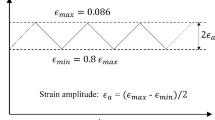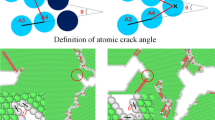Abstract
The fatigue crack propagation behavior of Ni3Al was studied using molecular dynamics simulation at room temperature. The simulation results showed that the deformation mechanisms and the crack propagation path were significantly influenced by the orientation of initial crack. The formation process of slip bands around the crack tip was investigated in various cracks and indicated that the slip bands were able to hinder the initiation and propagation of cracks. Besides, the crack growth rate was also calculated by the Paris equation, and the results revealed that the crack growth rate increased with the increasing stress intensity factor range.










Similar content being viewed by others
References
T.M. Pollock, A.S. Argon, Creep resistance of CMSX-3 nickel base superalloys single crystals. Acta Mater. 40, 1–30 (1992)
R.C. Reed, The Superalloys: Fundamentals and Applications (Cambridge University Press, New York, 2006), p. 372
F.R.N. Nabarro, H.L. Villiers, The Physics of Creep (Taylor and Francis, London, 1995)
M.G. Ardakani, M. McLean, B.A. Shollock, Twin formation during creep in single crystals of nickel-based superalloys. Acta Mater. 47, 2593 (1999)
K. Kakehi, Effect of plastic anisotropy of tensile strength of single crystals of an Ni-based superalloy. Scr. Mater. 42, 197 (1999)
A. Manonukul, F.P.E. Dunne, D. Knowles, Physically-based model for creep in nickel-base superalloy C263 both above and below the gamma solvus. Acta Mater. 50, 2917 (2002)
M. Kolbe, The temperature decrease of the critical resolved shear stress in nickel-base superalloys. Mater. Sci. Eng. 319–321, 383 (2001)
L. Kovarik, R.R. Unocic, J. Li, P. Sarosi, C. Shen, Y. Wanga, M.J. Mills, Microtwinning and other shearing mechanisms at intermediate temperatures in Ni-based superalloys. Progr. Mater. Sci. 54, 839 (2009)
D.M. Knowles, S. Gunturi, The role of 〈112〉{111} slip in the asymmetric nature of creep of single crystal superalloy CMSX-4. Mater. Sci. Eng., A 328, 223 (2002)
P.M. Sarosi, G.B. Viswanathan, M.J. Mills, Direct observation of an extended complex stacking fault in the gamma’ phase of a Ni-base superalloy. Scr. Mater. 55, 727 (2006)
E. Fleury, L. Remy, Behavior of nickel-base superalloy single crystals under thermal-mechanical fatigue. Metall. Mater. Trans. A 25, 99 (1994)
R. Chieragatti, L. Remy, Influence of orientations on the low cycle fatigue of MAR-M 200 single crystals at 650degC II. Cyclic stress-strain behavior. Mater. Sci. Eng., A 141, 11 (1991)
S. Kraft, R. Zauter, H. Mughrabi, Aspects of high-temperature low-cycle thermomechanical fatigue of a single nickel-base superalloy. Fatigue Fract. Eng. Mater. Struct. 16, 237 (1993)
J.J. Moverare, S. Johansson, Damage mechanisms of a high-Cr single crystal superalloy during thermomechanical fatigue. Mater. Sci. Eng., A 527, 553 (2010)
J. Kanesund, J. Moverare, S. Johansson, Deformation and damage mechanisms in IN792 during thermomechanical fatigue. Mater. Sci. Eng., A 528, 4658 (2011)
H.U. Hong, J.G. Kang, B.G. Choi, I.S. Kim, Y.S. Yoo, C.Y. Jo, A comparative study on thermomechanical and low cycle fatigue failures of a single crystal nickel-based superalloy. Int. J. Fatigue 33, 1592 (2011)
Fei Sun, Jianxin Zhang, Hiroshi Harada, Deformation twining and twinning-related fracture in nickel-base single-superalloys during thermomechanical fatigue cycling. Acta Mater. 67, 45–57 (2014)
H. Zhou, H. Harada, Y. Ro, I. Okada, Investigations on the thermo-mechanical fatigue of two Ni-based single-crystal superalloys. Mater. Sci. Eng., A 394, 161 (2005)
M. Dao, B.K. Kad, R.J. Asaro, Mechanism of intense shear failure in Ni3Al single crystals. Philos. Mag. A 75, 443 (1997)
X. Hong-Xian, W. Chong-Yu, Y. Tao et al., Dislocation formation and twinning from the crack tip in Ni3Al: molecular dynamics simulation. Chin. Phys. B 18, 0251 (2009)
H.-X. Xie, L. Bo, Y. Tao, Atomistic simulation of microtwinning at the crack tip in L12 Ni3Al. Philos. Mag. 92, 1542–1553 (2012)
H. Xie, Y. Tao, F. Yin et al., The effects of crack orientation on the twin formation from the crack tip in γ′-Ni3Al. Mater. Sci. Eng., A 580, 99–104 (2013)
G.P. Purja Pun, Y. Mishin, Development of an interatomic potential for the Ni–Al system. Philos. Mag. 89, 3245–3267 (2009)
Y. Mishin, D. Farkas, M.J. Mehl, D.A. Papaconstantopoulos, Interatomics potentials for monoatomic metals from experimental data and ab initio calculations. Phys. Rev. B 59, 3393 (1999)
S. Plimpton, Fast parallel algorithms for short-range molecular dynamics. J. Comp. Phys. 117, 1–19 (1995)
J.D. Honeycutt, H.C. Andersen, Molecular dynamics study of melting and freezing of small Lennard-Jones clusters. J. Phys. Chem. 91, 4950–4963 (1987)
G.P. Potirniche, M.F. Horstemeyer, B. Jelinek et al., Fatigue damage in nickel and copper single crystals at nanoscale. Int. J. Fatigue 27, 1179–1185 (2005)
G.P. Potirniche, M.F. Horstemeyer, On the growth of nanoscale fatigue cracks. Philos. Mag. Lett. 86(3), 185–193 (2006)
D. Farkas, M. Willemann, B. Hyde, Atomistic mechanisms of fatigue in nanocrystalline metals. Phys. Rev. Lett. 94, 165502 (2005)
G.P. Potirniche, M.F. Horstemeyer, P.M. Gullett et al., Atomistic modeling of fatigue crack growth and dislocation structuring in FCC crystals. Proc. R. Soc. A 462, 3707–3731 (2006)
Johannes Weertman, Dislocation crack tip shielding and the Pairs exponent. Mater. Sci. Eng., A 468, 59–63 (2007)
D. Roylance, “Fatigue”. Department of Materials Science and Engineering, Massachusetts Institute of Technology, Cambridge, MA 02139, 200
Acknowledgments
This work is supported by the NSFC (No. 51071063 and 11076012). We would also like to appreciate the support by Atomic Simulation Lab of Hunan University and the computation platform of National Super-Computer Center in Changsha.
Author information
Authors and Affiliations
Corresponding authors
Rights and permissions
About this article
Cite this article
Ma, L., Xiao, S., Deng, H. et al. Atomic simulation of fatigue crack propagation in Ni3Al. Appl. Phys. A 118, 1399–1406 (2015). https://doi.org/10.1007/s00339-014-8895-0
Received:
Accepted:
Published:
Issue Date:
DOI: https://doi.org/10.1007/s00339-014-8895-0




